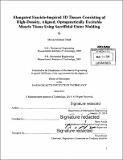| dc.contributor.advisor | Harry Asada. | en_US |
| dc.contributor.author | Neal, Devin Michael | en_US |
| dc.contributor.other | Massachusetts Institute of Technology. Department of Mechanical Engineering. | en_US |
| dc.date.accessioned | 2014-12-08T18:53:48Z | |
| dc.date.available | 2014-12-08T18:53:48Z | |
| dc.date.copyright | 2014 | en_US |
| dc.date.issued | 2014 | en_US |
| dc.identifier.uri | http://hdl.handle.net/1721.1/92166 | |
| dc.description | Thesis: Ph. D., Massachusetts Institute of Technology, Department of Mechanical Engineering, 2014. | en_US |
| dc.description | Cataloged from PDF version of thesis. | en_US |
| dc.description | Includes bibliographical references (pages 80-89). | en_US |
| dc.description.abstract | The majority of muscles, nerves, and tendons are composed of fiber-like fascicle morphology. Each fascicle has a) elongated cells highly aligned with the length of the construct, b) a high volumetric cell density, and c) a high length-to-width ratio with a diameter small enough to facilitate perfusion. Fiber-like fascicles are important building blocks for forming those tissues of various sizes and cross-sectional shapes, yet no effective technology is currently available for producing long and thin fascicle-like constructs with aligned, high-density cells. Here we present a method for molding cell-laden hydrogels that generate cylindrical tissue structures that are ~100 [mu]m in diameter with an extremely high length to diameter ratio (>100:1). Using this method we have successfully created skeletal muscle tissue with a high volumetric density (~50%) and perfect cell alignment along the axis. A new molding technique, Sacrificial Outer Molding, allows us to i) create long and thin cavities of desired shape in a mold that is solid at a low temperature, ii) release gelling agents from the sacrificial mold material after cellladen hydrogel is injected into fiber cavities, iii) generate a uniform axial tension between anchor points at both ends that promotes cell alignment and maturation, and iv) perfuse the tissue effectively by exposing it to media after melting the sacrificial outer mold at 37°C. Effects of key parameters and conditions, including initial cavity diameter, axial tension, and concentrations of hydrogel and gelling agent, upon tissue compaction, volumetric cell density, and cell alignment are presented. Furthermore, the tissue is characterized in a custom designed mechanical characterization system. Characterization has shown that an optimal diameter exists at which muscle constructs exhibit the greatest contraction performance, and that optical and electrical stimulation of optogenetic muscle cells result in similar performance if the tissue is developed sufficiently. | en_US |
| dc.description.statementofresponsibility | by Devin Michael Neal. | en_US |
| dc.format.extent | 142 pages | en_US |
| dc.language.iso | eng | en_US |
| dc.publisher | Massachusetts Institute of Technology | en_US |
| dc.rights | M.I.T. theses are protected by copyright. They may be viewed from this source for any purpose, but reproduction or distribution in any format is prohibited without written permission. See provided URL for inquiries about permission. | en_US |
| dc.rights.uri | http://dspace.mit.edu/handle/1721.1/7582 | en_US |
| dc.subject | Mechanical Engineering. | en_US |
| dc.title | Elongated fascicle-inspired 3D tissues consisting of high-density, aligned, optogenetically excitable muscle tissue using sacrificial outer molding | en_US |
| dc.type | Thesis | en_US |
| dc.description.degree | Ph. D. | en_US |
| dc.contributor.department | Massachusetts Institute of Technology. Department of Mechanical Engineering | |
| dc.identifier.oclc | 897133010 | en_US |
